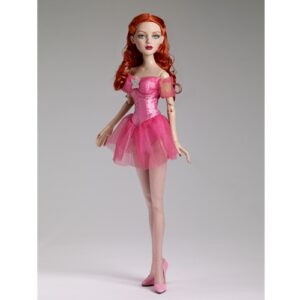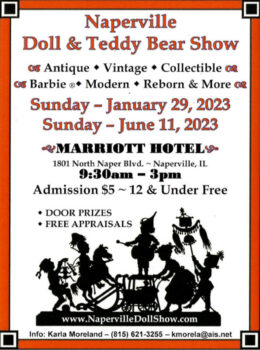If you’ve ever come across a beautiful Robert Tonner doll at a show, in an estate collection, or tucked away on a forgotten shelf, you might’ve wondered: Is it the real deal? When it comes to vintage Tonner dolls, knowing how to properly authenticate and date them is key—not just for understanding value, but for appreciating the story behind the doll.
At Gigi’s Dolls, we’ve helped collectors identify Tonner pieces for decades. And whether you’re just starting out or have a dozen Tyler Wentworths at home, here’s what you’ll want to look for when confirming a Tonner doll’s authenticity and production period.

What Counts as “Vintage” in the Tonner World?
Robert Tonner founded the Tonner Doll Company in 1991, so we’re not talking about antique dolls in the traditional sense. Still, for Tonner collectors, dolls from the early to mid-1990s through the early 2000s are often considered “vintage” simply because they’re part of the brand’s earliest creative output—and many are no longer being produced.
These are the dolls that helped define Tonner’s aesthetic and reputation: carefully sculpted, story-driven, and dressed in jaw-dropping fashion.
Early Signs of an Original Release
Those early years came with unique materials, face sculpts, and production quirks. If you’re holding a Tonner doll from the 1990s, chances are the body is less articulated than later models. You may also notice subtler paintwork, heavier vinyl, or a slightly different proportion compared to more recent releases.
These small design differences can be major clues when trying to place a doll in the right era.
Identifying the Real Thing: What to Check
Look for Markings – Most genuine Tonner dolls are marked on the back of the head or upper back with Robert Tonner’s name or initials. You might also find a year or model number, which can help narrow things down. These marks are generally molded into the vinyl and can sometimes be faint—especially if the doll’s been handled or cleaned frequently.
No marking? That’s not always a red flag, but it does mean you’ll need to rely more on other clues like the sculpt, outfit, and materials.
Examine the Quality – Tonner dolls were known for quality. Even older pieces should still feel sturdy in hand, with clean seam lines, well-blended face paint, and detailed eye and lip coloring. Anything that feels too lightweight, poorly painted, or off in proportion might be a reproduction or heavily altered doll.
Hair is another tell. Most Tonner dolls used high-quality synthetic hair that was rooted with care or, in the case of dolls like Ellowyne Wilde, wigs that were well made and easy to style. Matted or patchy hair might suggest heavy use or modification.
Dating a Tonner Doll: Context Is Everything
Box Labels and Certificates
The best-case scenario? A Tonner doll in its original box with the Certificate of Authenticity still included. Tonner packaging usually had clear, stylish branding with a printed label noting the doll’s name, collection, and year of release. Limited editions were numbered and included a COA—an excellent tool for identifying both the doll and its rarity.
We always recommend hanging onto original packaging if you have it. Not only does it help with identification, but it also increases resale value should you ever choose to part with a piece.
Fashion Clues and Collection Themes
Tonner released many dolls in seasonal fashion collections, so outfits can be one of your best tools for dating a doll. If you recognize the clothing but aren’t sure about the doll itself, search through Tonner catalogs or collector databases for a match.
We also keep past Tonner promotional materials on hand at Gigi’s Dolls, so if you bring in a mystery doll in a unique outfit, chances are good we can help figure out where she fits in.
Common Missteps When Identifying Tonner Dolls
Mixing and Matching Parts
Because Tonner dolls were all roughly the same scale, it’s not unusual to find a doll wearing clothes from another character—or even on a different body. While some collectors love mixing and customizing, it can make identifying the original doll more difficult.
If the outfit doesn’t seem to fit quite right or the style clashes with the sculpt, it’s worth double-checking whether you’re looking at a true original set.
Customized or Repainted Dolls
One of the amazing things about Tonner dolls is that they’re often used by artists for custom projects. But for someone trying to date or authenticate a piece, that can complicate things. Repainted faces, re rooted hair, and altered body parts can make even a well-known doll look totally unfamiliar.
If you suspect a doll has been customized, it’s a good idea to compare it with known stock photos of Tonner releases or ask an experienced collector for help.
Getting Help from the Experts
You don’t need to do it all on your own. If you’re unsure about a doll’s identity, bring it in! At Gigi’s Dolls, we love a good mystery. We’ve helped customers track down the origins of many Tonner dolls—sometimes even surprising longtime collectors with details they hadn’t known.
We can also advise on current market value, give tips on restoring or re accessorizing your dolls, and help you source hard-to-find original outfits or accessories.
Identifying and dating vintage Robert Tonner dolls is a blend of observation, experience, and a little detective work. But once you start to recognize the patterns—like marking placement, body types, and costume themes—it becomes easier (and more fun) to piece together each doll’s story.
If you’re looking to grow your Tonner collection or need help authenticating what you have, we’re always here to assist. Contact Gigi’s Dolls at 773-594-1540 today or visit us online for more information about our Robert Tonner Signature Dolls!


